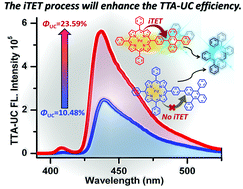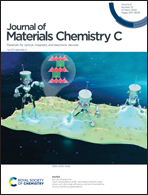Enhancing triplet sensitization ability of donor–acceptor dyads via intramolecular triplet energy transfer†
Abstract
Two covalently linked porphyrin palladium (PdPor)-9,10-diphenylanthracene (DPA) donor–acceptor (D–A) systems, connected through the 2-position (PdPor-2-DPA) or 9-position (PdPor-9-DPA) of DPA, are prepared as sensitizers of triplet–triplet annihilation upconversion (TTA-UC). The steady-state absorption spectra demonstrate that PdPor and DPA in these compounds are electronically independent in the ground state. Phosphorescence spectra and femtosecond transient absorption spectra reveal that ultrafast intramolecular triplet energy transfer (iTET) from the PdPor unit to the DPA unit can be conducted in PdPor-9-DPA but not in PdPor-2-DPA. This may be caused by the stronger electronic coupling between PdTPP and DPA in PdPor-9-DPA that is essential for Dexter type triplet energy transfer. In addition, these two dyads are used as a triplet energy donor in TTA-UC for sensitizing DPA. The maximum upconversion efficiency for PdPor-9-DPA is about 23.59%, which is much larger than that of PdPor-2-DPA (10.48%). These results confirm that the iTET efficiency would affect the upconversion efficiency when the D–A system is adopted as a triplet donor. This provides new insights into designing D–A systems with highly efficient iTET as candidates for triplet energy donors in TTA-UC.



 Please wait while we load your content...
Please wait while we load your content...